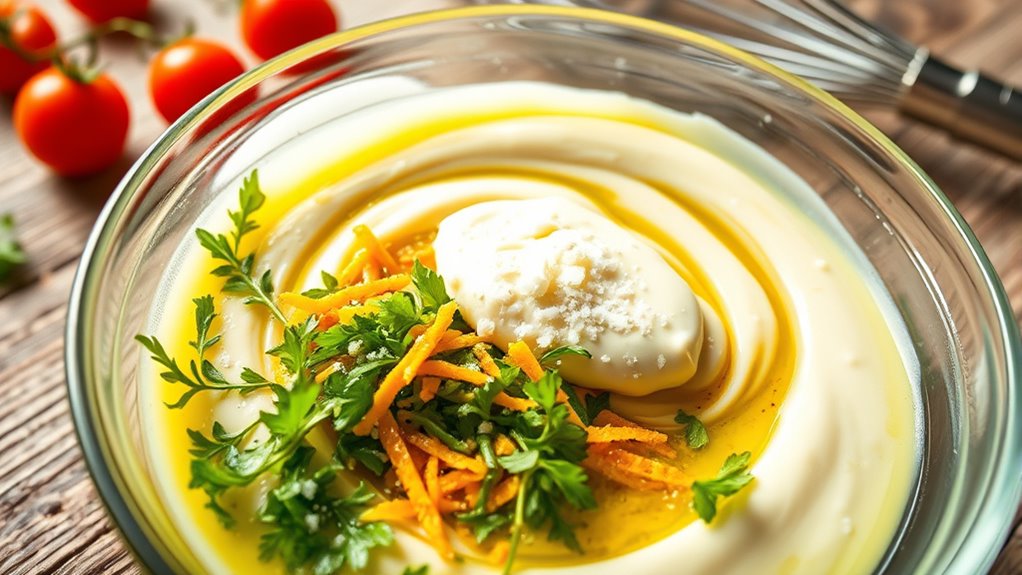In this Betty Salad Dressing, you blend 1/2 cup mayo, 2 tablespoons yogurt, 1 tablespoon lemon juice, 1 teaspoon Dijon mustard, and 1 teaspoon white wine vinegar into a glossy emulsion. Whisk until smooth, then taste and adjust with a touch of sugar or extra vinegar. Fold in fresh herbs at the end for aroma, chill, and drizzle over greens for bright, creamy balance. If you keep going, you’ll uncover more flavor tricks and tweaks.
Ingredients and Quantity
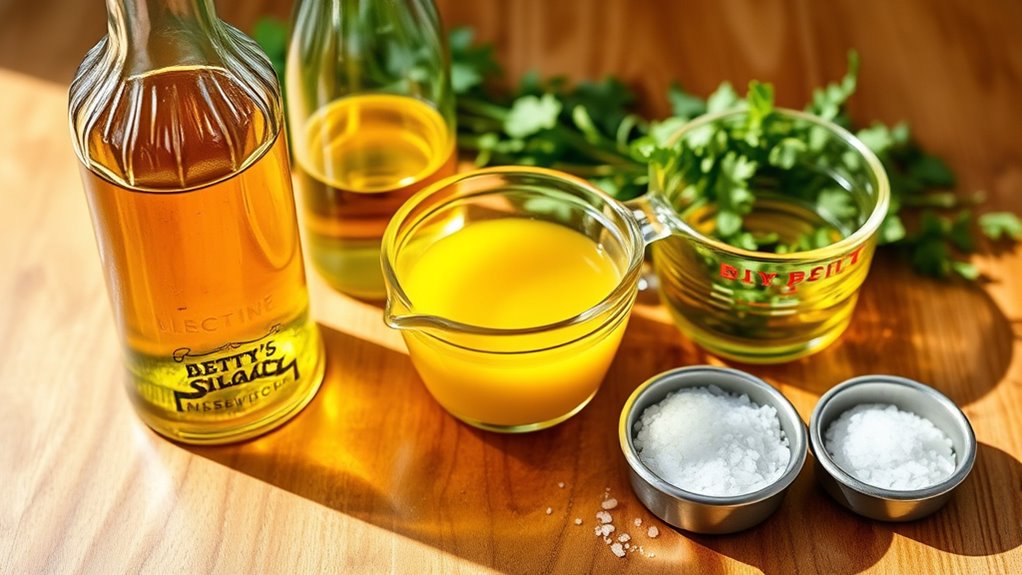
For the Betty salad dressing, gather these ingredients: 1/2 cup mayonnaise, 2 tablespoons yogurt, 1 tablespoon lemon juice, 1 teaspoon Dijon mustard, 1 teaspoon white wine vinegar, 1/2 teaspoon sugar, 1/4 teaspoon salt, and a pinch of black pepper.
| Fresh herbs | Purpose | Notes |
|---|---|---|
| Dill | bright lift | use finely chopped |
| Parsley | freshness | chopped fine |
| Chives | onion note | snip tiny |
You’ll sense flavor balance as you whisk: creamy body meets tang, a touch of sweetness, and herbaceous lift. Add fresh herbs last to preserve aroma. Keep thickness by adjusting mayo, yogurt, or a splash of water. You’re shaping freedom in a bowl, tasting, adjusting, deciding. The result is crisp, vibrant, and ready for your greens.
Preparations
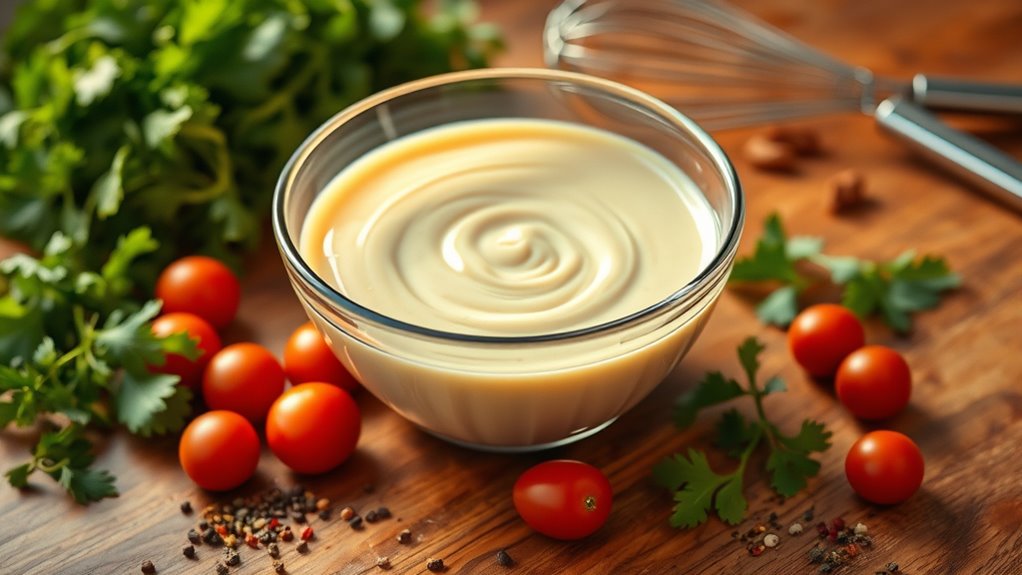
As you prep, gather your ingredients and tools, then combine the mayo, yogurt, lemon juice, Dijon mustard, white wine vinegar, sugar, salt, and pepper in a bowl. You’ll whisk until smooth, watching for a glossy, cohesive emulsion. Next, taste for balance and adjust with a pinch more sugar or a splash more vinegar, depending on your mood. Focus on preparation techniques that keep textures lively: whisk steadily, avoid clumps, and fold in a touch of extra yogurt if you want creaminess without heaviness. Consider flavor combinations as you go—a dash of garlic powder, cracked pepper, or fresh dill can alter the profile without overpowering the base. Streamline steps, finish with a brief rest, and keep the mix chilled until serving. Freedom, clarity, taste.
Kitchen tools or Kitchenware Required
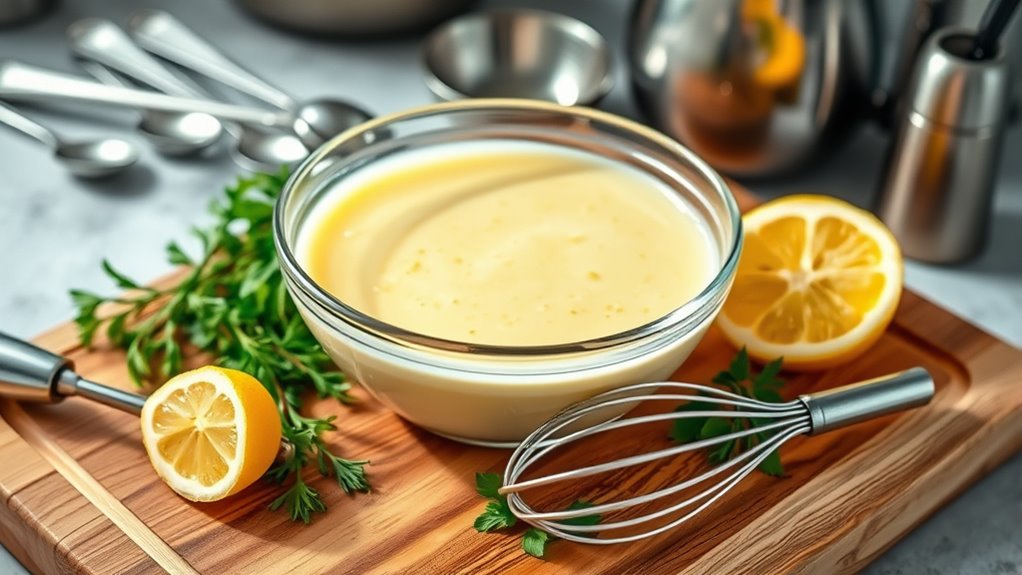
Here’s what you’ll reach for: a medium mixing bowl, a whisk or a sturdy spoon, and a measuring set for accuracy. You’ll feel the weight of your tools, hear the soft clink of glass, and smell fresh citrus as you prep. For blending, choose blender types that suit you: handheld wand for quick emulsions, compact personal blender, or a classic countertop unit. Keep storage containers close; clear jars let you see ingredients at a glance and lock in freshness. Maintain a tidy station; wipe surfaces as you go. Table below visualizes ideas.
| Tool Type | Purpose | Sensory cue |
|---|---|---|
| Mixing bowl | Base for emulsion | Cool ceramic, smooth rim |
| Whisk vs spoon | Agitation | Satisfying clink, rapid motion |
| Storage containers | Preserve leftovers | Airtight seal, crisp label |
How to Cook
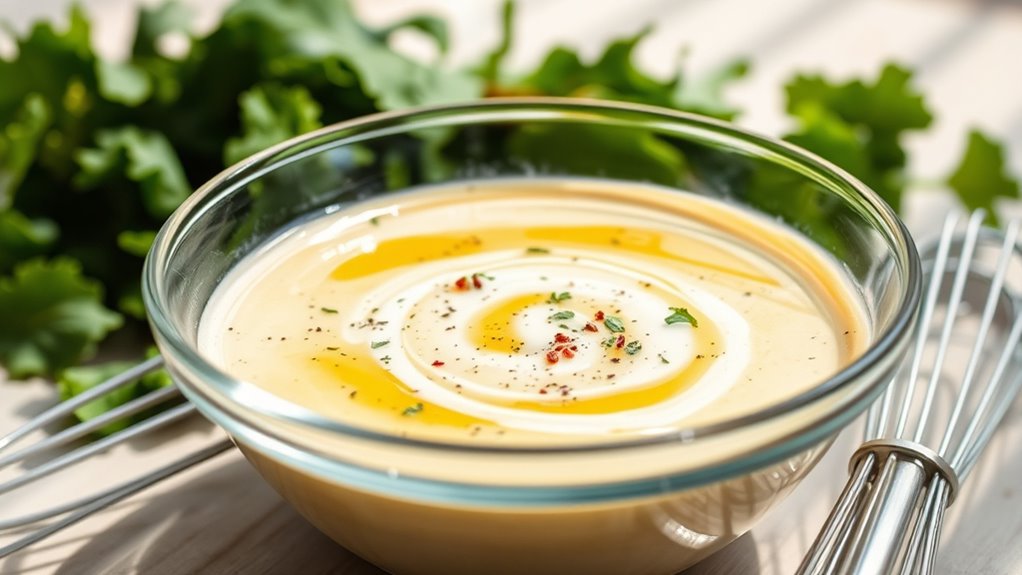
- Start with a clean bowl and steady hands.
- Whisk or shake your ingredients until they emulsify, noticing the texture thicken as air is incorporated.
- Keep the process simple: pour, blend, taste, and adjust as needed.
- Use confident, controlled motions to achieve a smooth consistency.
- Pause occasionally to observe how acidity brightens the dressing and oils cling to each particle.
- Choose cooking techniques based on your timing: quick emulsification for speed or slow folding for richer texture.
- Experiment with flavor combinations such as bright citrus with herbs, smoky paprika with garlic, or honey and mustard for warmth.
- Aim for a balanced flavor rather than heaviness.
- Finish with a final taste test before adding the dressing to your greens.
How to Serve
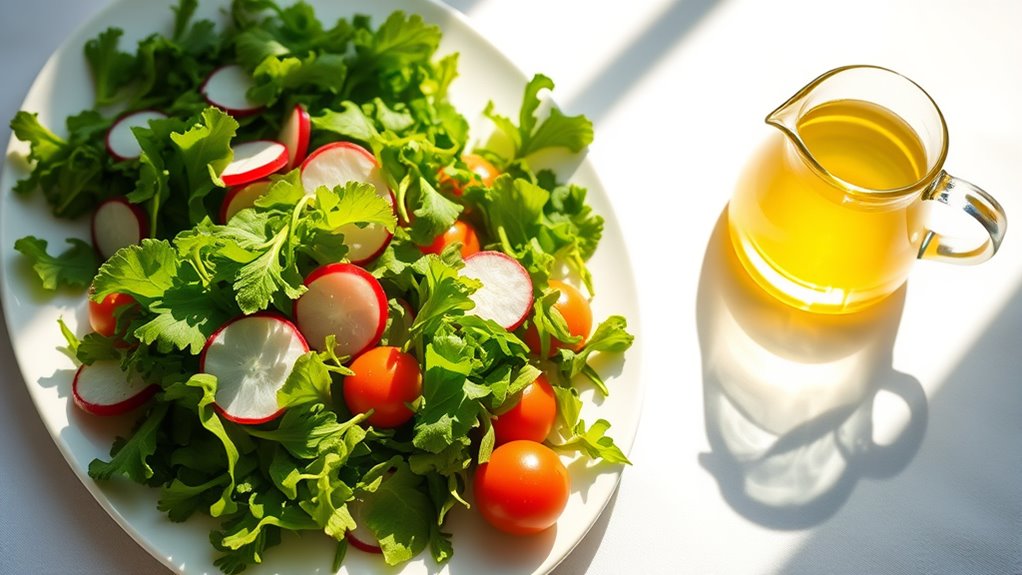
Pour the Betty dressing onto greens or into a small bowl at the table, so guests can judge the sheen and aroma up close. You’ll guide the moment with a confident pour, then invite bite-sized tasting, noting each note of citrus, cream, and herbs as it lands. For serving, keep it simple: a clean platter, crisp leaves, and a light toss to coat without drowning. Use a small pitcher or spoon to control drizzle, letting guests decide how much dressing is needed. Presentation ideas include arranging avocado, cherry tomatoes, and sliced radish for color contrast, or a minimalist chive garnish for a fresh finish. Serving suggestions should feel effortless, inviting, and vibrant, reinforcing the salad’s bright personality.
Tips
When building Betty, start with bright flavors: taste as you go and adjust with a splash of lemon or a pinch more salt to sharpen the citrus notes. Now, tips to keep your dressing vivid: balance oil and acid to finish silky, not greasy. Use fresh herbs for speed and scent, and whisk vigorously or shake in a jar for emulsification. For meal prep, measure by intuition but trust your palate—add mayo or yogurt for creaminess, or swap toward vinaigrette brightness with more vinegar. Think salad variations and dressing alternatives as freedoms, not rules. Store in a sealed container away from light. Taste after chilling; adjust with pepper, sugar, or mustard to refine the bite. Serve promptly for peak freshness.
Food Value and Benefit
Betty dressing offers a delicious combination of bright citrus flavors and balanced nutrition, making it a flavorful and healthful addition to your meals. The blend of olive oil and citrus not only enhances taste but also provides essential nutrients that support overall well-being.
Betty dressing blends bright citrus with olive oil for a flavorful, nutrient-rich addition to any meal.
Food Value:
- Rich in heart-healthy olive oil, providing monounsaturated fats
- Contains vitamin C from citrus, which supports immune function and skin health
- Includes soluble fiber from oats, promoting fullness and digestive health
Benefits of Eating Betty Dressing:
- Supports heart health through antioxidant-rich olive oil
- Boosts immune system with vitamin C content
- Helps maintain satiety and aids digestion thanks to soluble fiber
- Encourages mindful eating by enhancing flavor without heaviness
- Promotes steady energy levels and better focus throughout the day
Vitamins and Minerals:
- Vitamin C (from citrus)
- Vitamin E (from olive oil)
- Potassium (from citrus)
- Soluble fiber (from oats)
Incorporating Betty dressing into your meals is a simple way to enjoy great taste while nourishing your body and supporting your daily health goals.
Frequently Asked Questions
Can Betty Salad Dressing Be Made Dairy-Free?
Yes, you can make it dairy-free. Choose dairy alternatives like almond milk or olive oil-based emulsions, then whisk until creamy. Try vegan options such as tahini or cashew cream, and adjust flavors to taste for freedom.
How Long Does Betty Dressing Last in the Fridge?
Ever wonder how long Betty dressing lasts in the fridge? It keeps about 1 week safely. Shelf life depends on ingredients; store tightly in a sealed container. Follow storage tips: chill promptly, sniff, discard off-smell, and enjoy freely.
Can I Freeze Betty Dressing for Later Use?
Yes, you can freeze Betty dressing. Freeze in small, airtight containers or ice cube trays. Thaw overnight in the fridge, shake well, and taste for seasoning. Freezing tips: label date; storage methods: keep frozen up to 3 months.
What Are Substitutes for Mayonnaise in This Recipe?
“Where there’s a will, there’s a way.” You can swap mayo with vegan alternatives like mashed avocado, silken tofu, or yogurt; try olive oil emulsions. Flavor variations; you’ll taste freedom in every creamy, sensory bite.
Is Betty Dressing Good on Hot or Cold Salads?
Yes, you can enjoy Betty dressing on both hot and cold salads. It brightens hot salads with tang and sheen, while on cold salads it clings lightly, adding creaminess without overpowering the greens. Trust your palate, liberate your plate.
